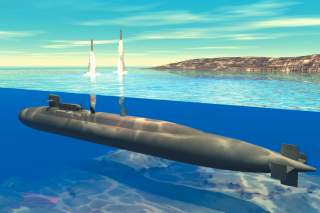The U.S. Navy Just Parked a Guided-Missile Submarine Right Near North Korea
And it could do some real damage if it has to.
As tensions with North Korea continue to rise, the United States continues to bring more long-range precision striking power into the region.
On October 13, USS Michigan (SSGN 727)—an Ohio-class guided-missile submarine—pulled into a South Korean naval base in the port city of Busan. While the U.S. Pacific Command states that Michigan’s visit to the Republic of Korea (ROK) was long planned, the message to North Korea is clear—the United States will stand by Seoul if Pyongyang makes any aggressive moves.
“The U.S. and ROK navies have always enjoyed a strong relationship. Today, our relationship is stronger than it has ever been and our ironclad partnership is further reinforced by this visit from Michigan." Rear Adm. Brad Cooper, commander, U.S. Naval Forces Korea said.
(Recommended: How America Could Go to War with Iran)
“Michigan Sailors were warmly welcomed by the ROK Navy today and I know they’ll receive the same wonderful welcome from the local community during their visit to Busan."
Originally constructed as a ballistic missile submarine armed with 24 Trident II D5 missiles, Michigan was converted into a cruise missile carrier in 2007 and is armed with 154 UGM-109 Tomahawk missiles. The massive 18,750-ton submarine carries those Tomahawk cruise missiles in 22 missiles tubes that were originally used to house Trident II D5 submarine launched ballistic missiles. These days, instead of a Trident, each tube houses a Multiple All Up Round Canister (MAC) that can hold seven Tomahawks—turning the SSBN into a SSGN.
(Recommended: Exposed: China's Super Strategy to Crush America in a War)
The two remaining Trident missiles tubes onboard the four Ohio-class SSGN conversions— Ohio, Michigan, Florida, and Georgia—were converted into lock-out tubes for special operations forces such as operators from the U.S. Navy’s elite SEAL Teams. Indeed, with SSGNs can host up to 66 special operations personnel and can also mount a dry-dock shelter and SEAL delivery vehicles. That makes the stealthy submarines an ideal weapon to insert other special operations forces into hostile territory—such as North Korea.
(Recommended: Japan's Master Plan to Defeat China in a War)
The Michigan and her crew will be in the region to familiarize themselves with America’s South Korean partners and learn to operate with their fleet to counter Pyongyang’s forces. Inserting special operations forces will likely be a skill Michigan’s crews will exercise during training exercises. The vessel entered port with dry-dock shelters attached to its upper hull. “We are looking forward to working with our [Republic of Korea Navy] partners and experiencing the Korean culture, which is a first for many of us,” Capt. Gustavo Gutierrez, Michigan’s commanding officer, said.
With any luck, Michigan’s job will simply be training and deterrence during her visit to Korea, but if worse comes to worse, she packs a very formidable punch.
Dave Majumdar is the defense editor for The National Interest. You can follow him on Twitter: @davemajumdar.

